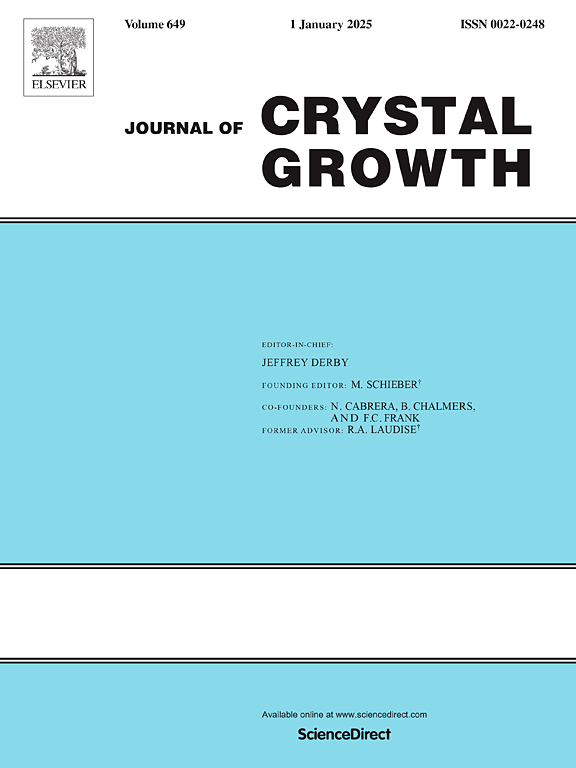Analysis and optimization of surface quality of polysilicon in a 45-pair rods reduction furnace
IF 1.7
4区 材料科学
Q3 CRYSTALLOGRAPHY
引用次数: 0
Abstract
To obtain dense polysilicon, the deposition rate of polysilicon needs to match the surface migration rate of silicon atoms. For this purpose, a numerical model has been established to simulate the deposition rate and the surface temperature of the polysilicon rods in a 45-pair rods reduction furnace. Meanwhile, the distributions of dense and non-dense polysilicon on the rod surface have been obtained based on the production data from the same reduction furnace. Further, by combining the numerical results and production data, a ratio Φ of deposition rate to temperature has been proposed. The results reveal that Φ of 8.0 × 10-7 kg·m-2·s-1·K-1 can be considered as a threshold to ensure the generation of dense polysilicon. Moreover, using the established numerical model, the operation conditions have been optimized. On the basis of existing operation conditions, reducing the surface temperature of the rods by 10 % and the trichlorosilane (TCS) feed rate by 10 % is beneficial for the generation of dense polysilicon. The results show that the proportion of non-dense polysilicon can be decreased to 2.3 % with a 4.3 % reduction in the deposition rate under the optimized operation conditions.
45对棒还原炉多晶硅表面质量分析与优化
为了获得致密的多晶硅,多晶硅的沉积速率需要与硅原子的表面迁移速率相匹配。为此,建立了模拟45对多晶硅棒还原炉中多晶硅棒沉积速率和表面温度的数值模型。同时,根据同一还原炉的生产数据,得到了密集多晶硅和非密集多晶硅在棒表面的分布。此外,结合数值结果和生产数据,提出了沉积速率与温度的比值Φ。结果表明,8.0 × 10-7 kg·m-2·s-1·K-1的Φ可以作为保证生成致密多晶硅的阈值。并利用所建立的数值模型对操作条件进行了优化。在现有操作条件的基础上,将棒体表面温度降低10%,三氯硅烷(TCS)进料量降低10%,有利于致密多晶硅的生成。结果表明,在优化的操作条件下,非致密多晶硅的比例可以降低到2.3%,沉积速率降低4.3%。
本文章由计算机程序翻译,如有差异,请以英文原文为准。
求助全文
约1分钟内获得全文
求助全文
来源期刊

Journal of Crystal Growth
化学-晶体学
CiteScore
3.60
自引率
11.10%
发文量
373
审稿时长
65 days
期刊介绍:
The journal offers a common reference and publication source for workers engaged in research on the experimental and theoretical aspects of crystal growth and its applications, e.g. in devices. Experimental and theoretical contributions are published in the following fields: theory of nucleation and growth, molecular kinetics and transport phenomena, crystallization in viscous media such as polymers and glasses; crystal growth of metals, minerals, semiconductors, superconductors, magnetics, inorganic, organic and biological substances in bulk or as thin films; molecular beam epitaxy, chemical vapor deposition, growth of III-V and II-VI and other semiconductors; characterization of single crystals by physical and chemical methods; apparatus, instrumentation and techniques for crystal growth, and purification methods; multilayer heterostructures and their characterisation with an emphasis on crystal growth and epitaxial aspects of electronic materials. A special feature of the journal is the periodic inclusion of proceedings of symposia and conferences on relevant aspects of crystal growth.
 求助内容:
求助内容: 应助结果提醒方式:
应助结果提醒方式:


